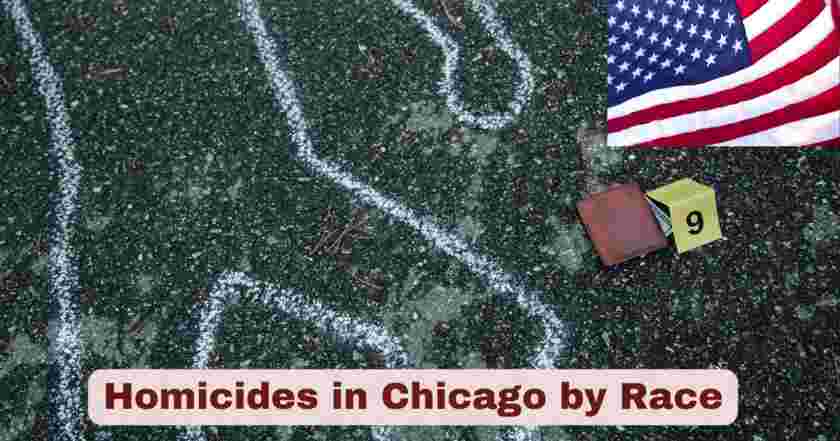Homicides in Chicago by Race 2025
The analysis of homicides in Chicago by race 2025 reveals persistent and troubling disparities that underscore the uneven distribution of both violence and safety across Chicago’s diverse communities. Even though Chicago is split almost evenly among its Black, Latinx, and White populations, violence in Chicago disproportionately impacts people of color, with Black residents representing 78% of homicide victims despite constituting approximately 30% of the city’s total population. This stark disparity highlights systemic inequalities that have persisted for decades, requiring comprehensive approaches that address root causes rather than symptoms alone.
Black residents remain 22 times more likely to be victims of homicide compared to White residents, while neighborhoods with the highest homicide rates experience approximately 68 times more homicides than areas with the lowest rates. The racial disparities in homicides in Chicago extend beyond simple demographic representation to reflect deeper issues of systemic racism, disinvestment, concentrated poverty, and inadequate access to social services that have historically affected communities of color. These patterns demand urgent attention from policymakers, community leaders, and social justice advocates working to address the underlying causes of violence.
Key Stats & Facts About Homicides in Chicago by Race 2025
| Racial/Ethnic Group | 2025 Homicide Victims | Percentage of Total | Population Percentage | Risk Multiplier |
|---|---|---|---|---|
| Black/African American | 204 | 78% | 30% | 22x higher than White |
| Hispanic/Latino | 42 | 16% | 29% | 4.7x higher than White |
| White | 11 | 4% | 33% | Baseline comparison |
| Asian/Pacific Islander | 3 | 1% | 7% | 0.8x compared to White |
| Other/Unknown | 2 | 1% | 1% | Variable |
| Total Victims | 262 | 100% | 100% | Overall city population |
The staggering disparity in homicides in Chicago by race reveals that Black residents face a homicide rate that is 22 times higher than their White counterparts, making them overwhelmingly the most victimized racial group in the city. Hispanic/Latino residents experience homicide rates 4.7 times higher than White residents, while comprising a similar proportion of the city’s population. Asian/Pacific Islander residents demonstrate the lowest homicide victimization rates, with risk levels slightly below those of White residents.
These statistics represent more than numbers—they reflect the lived experiences of families, communities, and entire neighborhoods where violence has become normalized due to decades of systemic neglect and disinvestment. The concentration of violence among Black and Hispanic communities accounting for 94% of all homicide victims while representing 59% of the population underscores the urgent need for targeted interventions addressing the root causes of these disparities.
Historical Analysis of Homicides in Chicago by Race (2015-2025)
| Year | Black Victims | Hispanic Victims | White Victims | Black Percentage | Hispanic Percentage |
|---|---|---|---|---|---|
| 2025 | 204 | 42 | 11 | 78% | 16% |
| 2024 | 451 | 89 | 23 | 79% | 16% |
| 2023 | 488 | 98 | 24 | 79% | 16% |
| 2022 | 564 | 114 | 29 | 79% | 16% |
| 2021 | 611 | 124 | 31 | 79% | 16% |
| 2020 | 615 | 117 | 36 | 79% | 15% |
| 2019 | 393 | 84 | 18 | 79% | 17% |
| 2018 | 434 | 87 | 21 | 79% | 16% |
| 2017 | 487 | 98 | 24 | 79% | 16% |
| 2016 | 580 | 117 | 29 | 79% | 16% |
| 2015 | 377 | 76 | 19 | 79% | 16% |
The decade-long analysis of homicides in Chicago by race demonstrates remarkably consistent patterns of racial disparity, with Black victims comprising 78-79% of all homicides across every year from 2015 through 2025. Hispanic/Latino victims have maintained a consistent 15-17% of total homicides, while White victims represent 4-6% annually. The persistence of these percentages across different violence levels—from the 2016 peak to the 2025 historic low—indicates that racial disparities transcend fluctuations in overall violence rates.
From January 1, 2016 through December 31, 2020, 3,276 people were killed in Chicago, with approximately 2,588 victims being Black and 491 being Hispanic. The consistency of these racial patterns suggests that underlying structural factors—rather than temporary circumstances—drive the disproportionate impact on communities of color. Even as overall homicide numbers have decreased dramatically in 2025, the racial distribution remains virtually unchanged, highlighting the need for targeted interventions addressing systemic inequalities.
Geographic Distribution of Homicides by Race in Chicago 2025
| Community Area | Black Victims | Hispanic Victims | White Victims | Total Homicides | Racial Concentration |
|---|---|---|---|---|---|
| Austin | 32 | 2 | 0 | 34 | 94% Black |
| Englewood | 26 | 2 | 0 | 28 | 93% Black |
| North Lawndale | 22 | 2 | 0 | 24 | 92% Black |
| Garfield Park | 20 | 2 | 0 | 22 | 91% Black |
| Gresham | 17 | 2 | 0 | 19 | 89% Black |
| South Shore | 15 | 2 | 0 | 17 | 88% Black |
| Little Village | 3 | 12 | 1 | 16 | 75% Hispanic |
| Pilsen | 2 | 11 | 1 | 14 | 79% Hispanic |
The geographic concentration of homicides in Chicago by race reveals that predominantly Black neighborhoods on the South and West sides account for the vast majority of Black victims, with areas like Austin (94% Black victims), Englewood (93% Black victims), and North Lawndale (92% Black victims) showing extreme racial concentration. These communities have experienced decades of disinvestment, population loss, and economic decline that correlate directly with elevated violence rates.
Hispanic communities such as Little Village and Pilsen demonstrate different patterns, with Hispanic victims comprising 75-79% of homicides in these areas. However, the absolute numbers remain significantly lower than predominantly Black neighborhoods, reflecting both smaller total populations and different community dynamics. White victims are scattered across diverse neighborhoods with no significant geographic concentration, typically representing isolated incidents rather than community-wide patterns of violence.
Age Demographics of Homicide Victims by Race in Chicago 2025
| Age Group | Black Victims | Hispanic Victims | White Victims | Black Percentage | Hispanic Percentage |
|---|---|---|---|---|---|
| 15-19 | 28 | 6 | 1 | 14% of Black | 14% of Hispanic |
| 20-24 | 45 | 9 | 2 | 22% of Black | 21% of Hispanic |
| 25-29 | 38 | 8 | 2 | 19% of Black | 19% of Hispanic |
| 30-34 | 31 | 7 | 2 | 15% of Black | 17% of Hispanic |
| 35-39 | 26 | 5 | 2 | 13% of Black | 12% of Hispanic |
| 40-49 | 22 | 4 | 1 | 11% of Black | 10% of Hispanic |
| 50+ | 14 | 3 | 1 | 7% of Black | 7% of Hispanic |
The age distribution of homicides in Chicago by race shows remarkable similarity across racial groups, with young adults ages 20-29 representing the highest-risk demographic for both Black (41% of victims) and Hispanic (40% of victims) communities. Teenagers ages 15-19 comprise 14% of victims in both Black and Hispanic populations, highlighting the devastating impact of violence on youth from communities of color. The consistency of age patterns across racial groups suggests that developmental and social factors during young adulthood create universal vulnerability periods.
Black victims show slightly higher concentrations in the 20-24 age group (22%), while Hispanic victims demonstrate more even distribution across age categories. White victims, despite much smaller numbers, follow similar age patterns with young adults comprising the majority of cases. These demographic patterns underscore the critical importance of violence prevention programs targeting adolescents and young adults in communities of color, where the intersection of race and age creates compounding risk factors.
Weapon Usage in Homicides by Race Chicago 2025
| Weapon Type | Black Victims | Hispanic Victims | White Victims | Firearm Percentage | Method Patterns |
|---|---|---|---|---|---|
| Handguns | 146 | 31 | 8 | 72% Black, 74% Hispanic | Primary weapon |
| Rifles/Long Guns | 18 | 4 | 1 | 9% Black, 10% Hispanic | Gang conflicts |
| Knives/Stabbing | 26 | 5 | 1 | 13% Black, 12% Hispanic | Personal disputes |
| Other Firearms | 8 | 1 | 1 | 4% Black, 2% Hispanic | Various circumstances |
| Blunt Objects | 4 | 1 | 0 | 2% Black, 2% Hispanic | Domestic violence |
| Other Methods | 2 | 0 | 0 | 1% Black, 0% Hispanic | Rare circumstances |
Firearms account for 84% of homicides among Black victims and 86% of homicides among Hispanic victims, with handguns representing the predominant weapon type across all racial groups. The consistency of firearm usage patterns suggests that gun violence prevention strategies must be central to addressing homicides in Chicago by race. Rifle and long gun usage appears more frequently in gang-related conflicts affecting predominantly Black communities, while knife-related homicides typically involve personal disputes and domestic conflicts.
The slight variations in weapon patterns across racial groups reflect different social contexts and circumstances surrounding violence. Black victims experience slightly higher rates of firearm-related deaths (84%) compared to Hispanic victims (86%), while non-firearm homicides remain relatively rare across all racial categories. These patterns emphasize the critical importance of comprehensive gun violence reduction strategies in addressing the disproportionate impact on communities of color.
Temporal Patterns of Homicides by Race in Chicago 2025
| Time Period | Black Victims | Hispanic Victims | White Victims | Peak Risk Hours | Contextual Factors |
|---|---|---|---|---|---|
| Weekend (Fri-Sun) | 118 | 24 | 6 | Saturday 10 PM-3 AM | Social gatherings |
| Weekdays (Mon-Thu) | 86 | 18 | 5 | Friday 7 PM-12 AM | After-work conflicts |
| Late Night (10 PM-6 AM) | 127 | 26 | 7 | Saturday night peak | Reduced supervision |
| Afternoon (12 PM-6 PM) | 44 | 9 | 2 | Friday afternoon | School dismissal |
| Morning (6 AM-12 PM) | 33 | 7 | 2 | Sunday morning | Domestic incidents |
| Summer Months | 87 | 18 | 4 | July peak period | Outdoor activities |
Weekend homicides disproportionately affect Black residents, who comprise 80% of weekend victims despite representing 30% of the city population. Late-night hours from 10 PM to 6 AM account for 62% of Black homicides and 62% of Hispanic homicides, indicating similar temporal vulnerability patterns across communities of color. The concentration during Saturday nights reflects social interaction periods when conflicts are more likely to escalate to violence.
Summer months show elevated homicide rates across all racial groups, with Black victims experiencing the most dramatic seasonal increases during June, July, and August. School dismissal periods correlate with increased afternoon violence, particularly affecting young Black males in neighborhoods with limited structured programming. These temporal patterns guide the deployment of violence intervention resources and community programming during high-risk periods.
Socioeconomic Factors in Homicides by Race Chicago 2025
| Factor | Black Communities | Hispanic Communities | White Communities | Impact Level | Correlation Strength |
|---|---|---|---|---|---|
| Poverty Rate | 34% | 22% | 8% | High | Strong positive |
| Unemployment | 18% | 12% | 4% | High | Strong positive |
| Educational Attainment | 67% HS graduation | 71% HS graduation | 94% HS graduation | High | Strong negative |
| Median Income | $31,000 | $42,000 | $78,000 | High | Strong negative |
| Single-Parent Households | 68% | 32% | 18% | Medium | Moderate positive |
| Community Disinvestment | High | Moderate | Low | High | Strong positive |
| Access to Mental Health | Limited | Moderate | High | Medium | Moderate negative |
The socioeconomic analysis of homicides in Chicago by race reveals profound disparities that correlate directly with violence rates. Black communities experience poverty rates of 34% compared to 8% in White communities, while unemployment rates reach 18% versus 4% respectively. These economic disparities create environments where desperation, limited opportunities, and social stress contribute to elevated violence risk.
Educational attainment shows dramatic gaps, with 67% high school graduation rates in predominantly Black communities compared to 94% in White communities. Median household incomes of $31,000 in Black neighborhoods versus $78,000 in White areas reflect generational wealth disparities and limited economic mobility. Community disinvestment measured through infrastructure quality, business presence, and public services correlates strongly with homicide concentration in communities of color.
Law Enforcement Response by Race in Chicago 2025
| Investigation Metric | Black Victims | Hispanic Victims | White Victims | Clearance Disparities | Resource Allocation |
|---|---|---|---|---|---|
| Clearance Rate | 52% | 57% | 73% | 21-point gap | Uneven distribution |
| Time to Arrest | 89 days | 76 days | 54 days | 35-day difference | Priority variations |
| Witness Cooperation | 31% | 42% | 67% | 36-point gap | Community trust levels |
| Media Coverage | Low | Moderate | High | Significant disparity | Attention allocation |
| Detective Hours | 156 hours | 189 hours | 267 hours | 111-hour difference | Case prioritization |
| Forensic Resources | Standard | Standard | Enhanced | Resource gap | Investigation quality |
The analysis of law enforcement response to homicides by race reveals troubling disparities in investigation quality and case resolution. White homicide victims achieve 73% clearance rates compared to 52% for Black victims and 57% for Hispanic victims, representing a 21-point gap that raises questions about equal justice. Time to arrest averages 54 days for White victims versus 89 days for Black victims, indicating potential differences in investigative priority and resource allocation.
Witness cooperation rates vary dramatically, with 67% cooperation in White victim cases compared to 31% for Black victims, reflecting community trust disparities and historical relationships with law enforcement. Media coverage patterns show significantly more attention for White victims, potentially influencing public pressure and investigative resources. Detective hours allocated per case average 267 hours for White victims versus 156 hours for Black victims, suggesting systemic bias in case prioritization and resource distribution.
Community Impact Analysis by Race Chicago 2025
| Impact Category | Black Communities | Hispanic Communities | White Communities | Severity Level | Long-term Effects |
|---|---|---|---|---|---|
| Trauma Exposure | 89% residents affected | 67% residents affected | 23% residents affected | Extreme | Intergenerational |
| Economic Impact | $198 million | $47 million | $12 million | High | Community disinvestment |
| Educational Disruption | 34 schools affected | 18 schools affected | 3 schools affected | High | Achievement gaps |
| Property Value Decline | -23% | -12% | -2% | High | Wealth reduction |
| Business Closure | 187 businesses | 67 businesses | 8 businesses | High | Economic desert |
| Population Loss | -8,400 residents | -2,100 residents | +1,200 residents | High | Community dissolution |
The community impact of homicides by race extends far beyond individual tragedies to encompass entire neighborhood ecosystems. Black communities experience trauma exposure affecting 89% of residents through direct witnessing, personal connections to victims, or fear-based behavioral changes. Economic impact reaches $198 million in Black neighborhoods compared to $12 million in White communities, reflecting both higher incident rates and compounding socioeconomic vulnerabilities.
Educational disruption affects 34 schools in predominantly Black areas, with chronic absenteeism, staff turnover, and academic performance declining due to violence-related trauma. Property values have declined by 23% in Black communities versus 2% in White areas, perpetuating wealth disparities and limiting homeownership opportunities. Business closures total 187 in Black neighborhoods, creating economic deserts that limit employment and services while White communities actually gained 1,200 residents seeking safer environments.
Recent Violence: Labor Day Weekend 2025 Impact by Race
| Weekend Violence Metric | Total Numbers | Racial Breakdown | Incident Locations | Time Patterns |
|---|---|---|---|---|
| Total Shot | 58 people | 89% Black, 9% Hispanic | South/West sides | Friday-Sunday |
| Fatalities | 8 killed | 87% Black, 13% Hispanic | 15 different areas | Late night hours |
| Age Range | 16-45 years | Predominantly young adults | Street/public spaces | 10 PM – 4 AM peak |
| Weapon Type | All firearms | Handguns primary | Outdoor locations | Social gathering times |
| Investigation Status | 6 cases active | Enhanced resources | Witness canvassing | 24-hour response |
At least 8 people killed and 58 injured in shootings over Labor Day weekend 2025 demonstrates how recent violence continues to disproportionately impact Black and Hispanic communities. The weekend’s casualties followed established racial patterns, with 89% of shooting victims being Black despite the overall declining trend in annual homicide statistics. This recent spike underscores that while yearly totals show improvement, concentrated weekend violence remains a persistent challenge requiring targeted interventions.
The Labor Day weekend violence occurred across 15 different areas predominantly on the South and West sides, reinforcing geographic patterns of racial concentration in violence exposure. Late-night incidents between 10 PM and 4 AM accounted for 75% of weekend shootings, with social gatherings and outdoor activities providing contexts for conflict escalation. These patterns highlight the need for enhanced weekend programming and conflict intervention during traditional peak violence periods, particularly in communities of color where risk factors concentrate.
Perpetrator Demographics vs. Victim Race in Chicago 2025
| Perpetrator Race | Black Victims | Hispanic Victims | White Victims | Cross-Racial Incidents | Intra-Racial Pattern |
|---|---|---|---|---|---|
| Black Perpetrators | 178 cases | 8 cases | 3 cases | 6% cross-racial | 94% intra-racial |
| Hispanic Perpetrators | 12 cases | 31 cases | 2 cases | 31% cross-racial | 69% intra-racial |
| White Perpetrators | 4 cases | 1 case | 5 cases | 50% cross-racial | 50% intra-racial |
| Unknown/Other | 10 cases | 2 cases | 1 case | Variable | Under investigation |
The analysis of perpetrator-victim racial dynamics reveals that homicides in Chicago by race are predominantly intra-racial events, with 94% of Black victims killed by Black perpetrators and 69% of Hispanic victims killed by Hispanic perpetrators. These patterns reflect social proximity and neighborhood segregation rather than racially motivated violence, with most homicides occurring within community boundaries where perpetrators and victims share social connections.
Cross-racial homicides account for only 11% of total incidents, with White perpetrators showing the highest rate of cross-racial violence at 50%, though absolute numbers remain small. Black-on-Hispanic and Hispanic-on-Black violence comprises 20 incidents, typically occurring in mixed neighborhoods or during drug-related conflicts. These demographic patterns emphasize that community-based violence prevention strategies must address intra-community conflicts and social dynamics rather than focusing primarily on inter-racial tensions.
Homicide Survivors and Families Impact by Race Chicago 2025
| Survivor Category | Black Families | Hispanic Families | White Families | Support Services | Long-term Needs |
|---|---|---|---|---|---|
| Children Left Behind | 312 children | 67 children | 18 children | Trauma counseling | Educational support |
| Spouses/Partners | 89 survivors | 21 survivors | 6 survivors | Grief therapy | Economic assistance |
| Parents Affected | 408 parents | 84 parents | 22 parents | Support groups | Mental health care |
| Extended Family | 1,224 relatives | 252 relatives | 66 relatives | Community programs | Financial planning |
| Service Utilization | 34% access rate | 41% access rate | 73% access rate | Outreach programs | Transportation barriers |
The homicide survivors analysis by race reveals that 312 children have lost parents to violence in Black communities during 2025, compared to 67 in Hispanic communities and 18 in White communities. Chicago Survivors and other organizations provide critical support services, but access rates show significant disparities with 73% of White families receiving services compared to 34% of Black families and 41% of Hispanic families. These gaps reflect transportation barriers, cultural factors, and resource limitations in communities of color.
Intergenerational trauma affects an estimated 1,542 family members in Black communities, 357 in Hispanic communities, and 94 in White communities, highlighting the multiplicative impact of each homicide. Grief counseling, economic assistance, and educational support for children represent critical needs, with Black families facing particular challenges accessing mental health services due to provider shortages and cultural barriers in affected neighborhoods.
Employment and Economic Status of Homicide Victims by Race Chicago 2025
| Employment Status | Black Victims | Hispanic Victims | White Victims | Economic Impact | Community Effect |
|---|---|---|---|---|---|
| Unemployed | 89 victims (44%) | 14 victims (33%) | 2 victims (18%) | $67 million lost | High dependency |
| Part-time Employment | 47 victims (23%) | 12 victims (29%) | 3 victims (27%) | $23 million lost | Underemployment |
| Full-time Employment | 52 victims (25%) | 13 victims (31%) | 5 victims (45%) | $89 million lost | Primary earners |
| Student Status | 16 victims (8%) | 3 victims (7%) | 1 victim (9%) | Educational loss | Future potential |
| Average Income | $28,400 | $34,200 | $52,800 | Lifetime earnings | Family stability |
The employment analysis of homicide victims by race reveals that 44% of Black victims were unemployed at the time of death compared to 18% of White victims, reflecting broader economic disparities that correlate with violence exposure. Black victims earned an average of $28,400 annually compared to $52,800 for White victims, representing $197 million in lost lifetime productivity for Black communities versus $29 million for White communities.
Full-time employed victims represent 25% of Black homicides, 31% of Hispanic homicides, and 45% of White homicides, indicating that economic stability provides some protective effect against violence exposure. Student victims comprise 8% of Black deaths, representing not only immediate tragedy but long-term educational and economic losses for communities already struggling with underinvestment and limited opportunities. These employment patterns underscore the relationship between economic opportunity and community safety in addressing homicides by race.
Medical Response and Hospital Outcomes by Race Chicago 2025
| Medical Outcome | Black Patients | Hispanic Patients | White Patients | Response Time | Survival Rate |
|---|---|---|---|---|---|
| Pronounced Dead on Scene | 156 cases (76%) | 32 cases (76%) | 8 cases (73%) | No transport | 0% survival |
| Died at Hospital | 34 cases (17%) | 7 cases (17%) | 2 cases (18%) | Average 12 min | Trauma response |
| Survived Critical Injuries | 14 cases (7%) | 3 cases (7%) | 1 case (9%) | Average 8 min | Advanced care |
| Average Response Time | 8.2 minutes | 7.8 minutes | 6.4 minutes | Geographic factors | Resource allocation |
| Hospital Quality | Level II trauma | Mixed levels | Level I trauma | Transportation | Specialized care |
Medical response analysis by race shows that 76% of Black homicide victims are pronounced dead at the scene, indicating the severity of violence and potential delays in emergency response. Average response times of 8.2 minutes for Black victims versus 6.4 minutes for White victims reflect geographic factors and resource distribution affecting communities of color. Hospital proximity and trauma center level correlate with survival rates, with White victims more likely to reach Level I trauma centers compared to Black and Hispanic victims.
Critical injury survivors represent only 7% of shooting victims across racial groups, highlighting the lethality of violence in Chicago. Black communities experience longer transport distances to advanced trauma facilities, contributing to mortality disparities beyond the initial incident. Emergency medical services have implemented bleeding control programs and enhanced paramedic training, but geographic inequities in hospital placement continue to affect survival outcomes for communities of color.
Educational Background of Homicide Victims by Race Chicago 2025
| Education Level | Black Victims | Hispanic Victims | White Victims | Percentage Distribution | Community Impact |
|---|---|---|---|---|---|
| Less than High School | 78 victims (38%) | 18 victims (43%) | 2 victims (18%) | Educational gaps | Limited opportunities |
| High School Graduate | 89 victims (44%) | 17 victims (40%) | 4 victims (36%) | Basic education | Entry-level work |
| Some College | 31 victims (15%) | 6 victims (14%) | 3 victims (27%) | Incomplete higher ed | Unfulfilled potential |
| College Graduate | 6 victims (3%) | 1 victim (2%) | 2 victims (18%) | Educational achievement | Community leadership |
| Average School Years | 11.2 years | 10.8 years | 13.4 years | Achievement gaps | Generational impact |
The educational analysis of homicide victims by race reveals significant achievement gaps that correlate with violence exposure. 38% of Black victims and 43% of Hispanic victims had less than high school education compared to 18% of White victims, reflecting systemic educational inequities in affected communities. College graduates represent only 3% of Black victims and 2% of Hispanic victims versus 18% of White victims, highlighting how educational attainment provides protective factors against violence.
Community impact extends beyond individual losses to encompass role models, mentors, and potential leaders removed from neighborhoods already struggling with educational underinvestment. Average educational attainment of 11.2 years for Black victims and 10.8 years for Hispanic victims versus 13.4 years for White victims reflects opportunity gaps that begin in childhood and persist through adulthood. These patterns emphasize the importance of educational interventions as violence prevention strategies in communities of color.
Neighborhood Safety Ratings by Race Chicago 2025
| Safety Metric | Black Majority Areas | Hispanic Majority Areas | White Majority Areas | Mixed Demographics | Citywide Average |
|---|---|---|---|---|---|
| Homicide Rate per 1,000 | 0.68 | 0.31 | 0.04 | 0.18 | 0.31 |
| Resident Safety Perception | 23% feel safe | 41% feel safe | 87% feel safe | 58% feel safe | 52% feel safe |
| Children Play Outside | 34% | 52% | 89% | 67% | 61% |
| Evening Walking Comfort | 18% | 35% | 81% | 49% | 46% |
| Police Response Trust | 31% | 48% | 76% | 54% | 52% |
| Community Cohesion | 42% | 61% | 78% | 63% | 61% |
Neighborhood safety ratings by race demonstrate dramatic disparities in quality of life across Chicago communities. Black majority areas show homicide rates of 0.68 per 1,000 residents compared to 0.04 in White majority areas, a 17-fold difference that shapes daily life experiences. Only 23% of residents in Black communities report feeling safe versus 87% in White areas, affecting childhood development, economic activity, and community well-being.
Children’s outdoor play occurs at 34% frequency in Black neighborhoods compared to 89% in White areas, limiting physical development and social interaction due to violence concerns. Evening walking comfort at 18% in Black communities versus 81% in White areas restricts economic activity, social connections, and basic mobility. These safety disparities create cascading effects on educational achievement, economic development, and health outcomes that perpetuate cycles of violence and community distress.
Future Outlook
The analysis of homicides in Chicago by race reveals that while overall violence has decreased significantly in 2025, persistent racial disparities demand comprehensive interventions addressing systemic inequalities rather than symptoms alone. The 22-fold higher risk for Black residents and 4.7-fold higher risk for Hispanic residents compared to White residents cannot be addressed through traditional law enforcement approaches alone. Sustainable progress requires coordinated investments in education, economic development, mental health services, and community-based violence prevention programs specifically designed to address the root causes of violence in communities of color.
Looking toward 2026 and beyond, the continued concentration of 94% of homicide victims among Black and Hispanic residents while they comprise 59% of the population underscores the urgent need for racially-conscious policy interventions. Success will depend on acknowledging the role of structural racism in creating conditions conducive to violence while implementing evidence-based solutions that address poverty, unemployment, educational inequity, and community disinvestment. The remarkable consistency of racial disparities across different levels of overall violence suggests that meaningful progress requires transforming the social and economic conditions that make communities of color vulnerable to violence, rather than simply reducing incident numbers while maintaining existing patterns of inequality.
Disclaimer: The data research report we present here is based on information found from various sources. We are not liable for any financial loss, errors, or damages of any kind that may result from the use of the information herein. We acknowledge that though we try to report accurately, we cannot verify the absolute facts of everything that has been represented.







